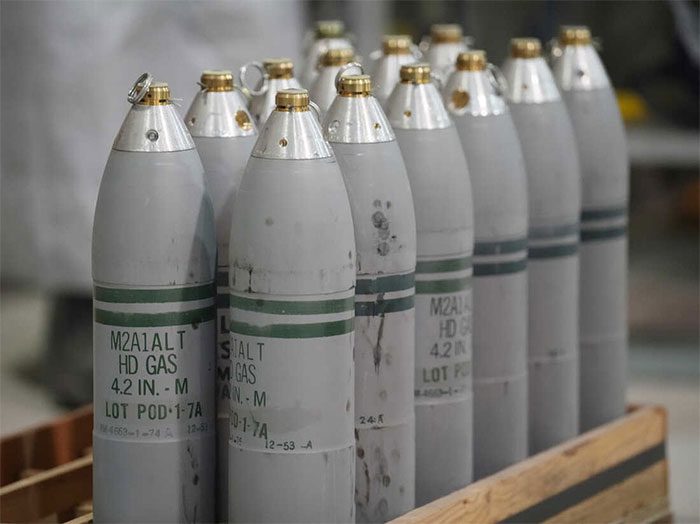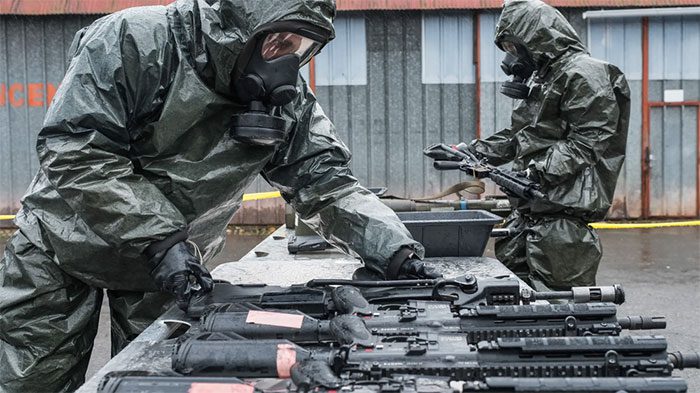On July 7, 2023, the U.S. Department of Defense (DOD) announced: “The U.S. has completed the destruction of its chemical weapon stockpile.”
U.S. officials declared that the last remaining weapon in the nation’s outdated chemical weapon stockpile had been safely destroyed—a disarmament milestone decades in the making—under the regulations of the Organization for the Prohibition of Chemical Weapons.
At its peak in the mid-1980s, the U.S. possessed 30,000 tons of chemical warfare agents. These included nerve agents such as Sarin and Tabun, which disrupt the mechanisms by which nerves transmit messages to organs, as well as blistering agents like mustard gas, which cause severe irritation to the skin, eyes, and lungs.
Today, that number is officially zero.
On July 7, 2023, the final M55 rocket containing the nerve agent Sarin was punctured, drained, and burned at the Blue Grass Army Depot in Kentucky, USA: Officially marking the end of humanity’s use of chemical weapons.
As the last country to declare possession of these terrifying war tools, this latest action signifies that the world is officially free of chemical weapons—at least on paper.

The U.S. once had over 30,000 tons of chemical weapons but has ultimately eliminated its last stockpile. (Photo: David Zalubowski/AP)
“This is the first time an international agency has verified the destruction of an entire declared stockpile of weapons of mass destruction—reinforcing the U.S. commitment to creating a world free of chemical weapons,” said Dr. William A. LaPlante, the U.S. Under Secretary of Defense.
It has been over 30 years since U.S. President George Bush and Soviet leader Mikhail Gorbachev agreed to end the production of all chemical weapons and destroy their respective stockpiles.
The Haunting Legacy of Chemical Weapons
Chemical weapons were first used extensively in World War I (1914-1918). During World War II (1939-1945), countries around the world stockpiled chemical weapons, preparing for their potential reuse.
During the Cold War (1946-1991), the U.S. and the Soviet Union amassed large arsenals of chemical weapons. By 1990, the U.S. had over 30,000 tons of chemical agents, while the Soviet Union may have had at least 40,000 tons, according to David Koplow, a law professor at Georgetown University in Washington, D.C.
- Chlorine gas was one of the first agents deployed on a large scale, causing irritation to the eyes and throat of anyone unfortunate enough to find themselves unprotected in its pale green mist.
- Mustard gas causes blisters to form anywhere it accumulates on exposed skin.
- Colorless Phosgene gas (COCl₂) silently destroys the lungs, leading to a painful death days later.
Although reluctant to use them, the U.S. and other world powers continued to invest in the development and production of increasingly toxic weapons.
In the 1950s, nerve agents like VX and Sarin were produced and integrated into explosive dispersal systems. Deadly at the smallest concentrations, these compounds block critical nerves, causing paralysis that leads to suffocation and death.
The practicality of dismantling an old chemical weapon stockpile has been nearly daunting. Designed to explode and devastate our tissues, few believed it wise to load these toxins onto boats, release them at sea, and sink them. Even after the destruction process concludes, cleanup at the facilities will continue for many years.

French soldiers participate in a nuclear, biological, and chemical warfare training exercise. (Photo: Fred Marie/Shutterstock.com).
“This process involves handling secondary waste, decontamination, decommissioning of facilities and equipment, handling assets, demolishing some structures, and concluding contracts as well as environmental permits. During the closure period, the safety of the workforce, community, and environment will remain the program’s top priority,” said Michael S. Abaie, Executive Director of the Chemical Weapons Alternative Solutions Program, U.S. Department of Defense.
With available facilities, the U.S. has finally caught up with the rest of the world, using robots to handle what humans should not; employing bacteria to break down what chemicals cannot; and using furnaces to quickly convert contaminated metals into slag and ash.
The United Kingdom declared the destruction of its last declared chemical weapon in 2007. India made a similar declaration in 2009. In 2017, Russia officially destroyed its final stockpile of 40,000 tons.
Thanks to these efforts, the amount of weapons causing painful death to humans on Earth has significantly decreased. This is a moment worth celebrating.


















































